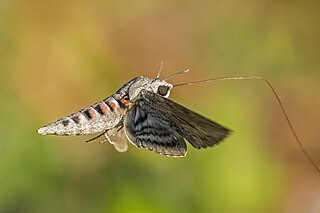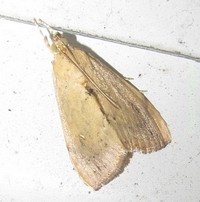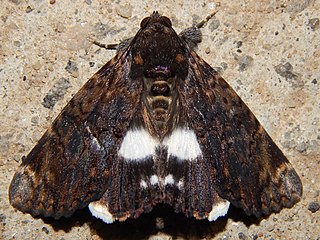
Agrius convolvuli, the convolvulus hawk-moth, is a large hawk-moth. It is common throughout Europe, Asia, Africa, Australia and New Zealand, partly as a migrant. In New Zealand, it is also known in the Māori language as hīhue.

Theretra nessus, the yam hawk moth, is a moth of the family Sphingidae. It was described by Dru Drury in 1773.
Melastrota is a monotypic moth genus in the subfamily Arctiinae erected by George Hampson in 1905. Its only species, Melastrota nigrisquamata, was described by Swinhoe in 1901. It is found in Australia, where it has been recorded from Queensland.
Phaeophlebosia is a monotypic moth genus in the subfamily Arctiinae erected by George Hampson in 1900. Its single species, Phaeophlebosia furcifera, the forked footman, was first described by Francis Walker in 1854. It is found in Australia, where it has been recorded from New South Wales, Victoria, Tasmania and South Australia.

Crocidolomia is a genus of moths of the family Crambidae.
Prooedema is a monotypic moth genus of the family Crambidae described by George Hampson. Its only species, Prooedema inscisalis, described by Francis Walker in 1865, is found in India, China, Indonesia, the Philippines, Papua New Guinea and Australia, where it has been recorded from the Northern Territory and Queensland.
Rhimphaliodes is a monotypic moth genus of the family Crambidae described by George Hampson in 1893. Its only species, Rhimphaliodes macrostigma, described by the same author in the same year, is found in Sri Lanka, on Borneo and in Australia, where it has been recorded from Queensland.

Crocidolomia pavonana is a moth of the family Crambidae. Its caterpillar is a crop pest and is known as the croci or the cabbage cluster caterpillar. This moth is found in Africa and Asia, its range extending from South Africa through India to the Pacific Ocean, including Australia. The wingspan is about 25 mm (1 in). The larvae feed on Brassicaceae species and are considered an agricultural pest on cabbages. At first, they feed only on the undersides of the leaves. Later they feed on the rest of the leaves and the central shoot. The species was first described by Johan Christian Fabricius in 1794.

Hypsopygia is a genus of moths belonging to the family Pyralidae. Though fairly small, they are large among their relatives. It was described by Jacob Hübner in 1825.

Simplicia cornicalis is a litter moth of the family Erebidae. The species was first described by Johan Christian Fabricius in 1794. It is found in south-eastern Asia and the Pacific. Records include New Caledonia, Réunion, Thailand, Fiji, Hawaii, India, Sri Lanka, the Society Islands, as well as New South Wales and Queensland in Australia. It is an introduced species in southern Florida and Louisiana in the United States.

Agrotera basinotata is a moth of the family Crambidae described by George Hampson in 1891. It is native to Queensland, Thailand, Hong Kong and Japan, but was introduced to Hawaii for the control of Melastoma malabathricum.

Banisia myrsusalis, the sapodilla borer or sapota midrib folder, is a species of moth of the family Thyrididae. It was described by Francis Walker in 1859 and is found in North America, Brazil, Australia, southern Asia and Africa.

Nagia linteola is a species of moth in the family Erebidae first described by Achille Guenée in 1852. This species occurs in South Africa, the Democratic Republic of the Congo, Yemen, the Comoros, Mauritius, Madagascar, Indonesia (Borneo), India, Sri Lanka, Myanmar, Thailand and in Australia, where it has been recorded from Western Australia, the Northern Territory, Queensland and Victoria.
Parapoynx dentizonalis is a moth in the family Crambidae. It was described by George Hampson in 1897. It is found in Australia, where it has been recorded from Queensland.
Calamotropha delatalis, is a moth in the family Crambidae. It was described by Francis Walker in 1863. It is found in Sri Lanka and Australia, where it has been recorded from Queensland, New South Wales and Victoria.
Achyra nigrirenalis is a moth in the family Crambidae. It was described by George Hampson in 1913. It is found in Australia, where it has been recorded from Western Australia, the Northern Territory, Queensland and South Australia.
Anania perflavalis is a moth in the family Crambidae. It was described by George Hampson in 1913. It is found in Australia, where it has been recorded from Queensland and New South Wales.

Orphanostigma angustale is a moth in the family Crambidae. It was described by George Hampson in 1893. It is found on New Guinea and in Australia, where it has been recorded from Queensland.
Prophantis androstigmata is a moth in the family Crambidae. It was described by George Hampson in 1918. It is found on New Guinea and Australia, where it has been recorded from Queensland.

Rivula basalis is a moth of the family Erebidae first described by George Hampson in 1891. It is found in South India, Sri Lanka, Indo-China, Thailand, South China, Taiwan, Java, Bali and Borneo.











